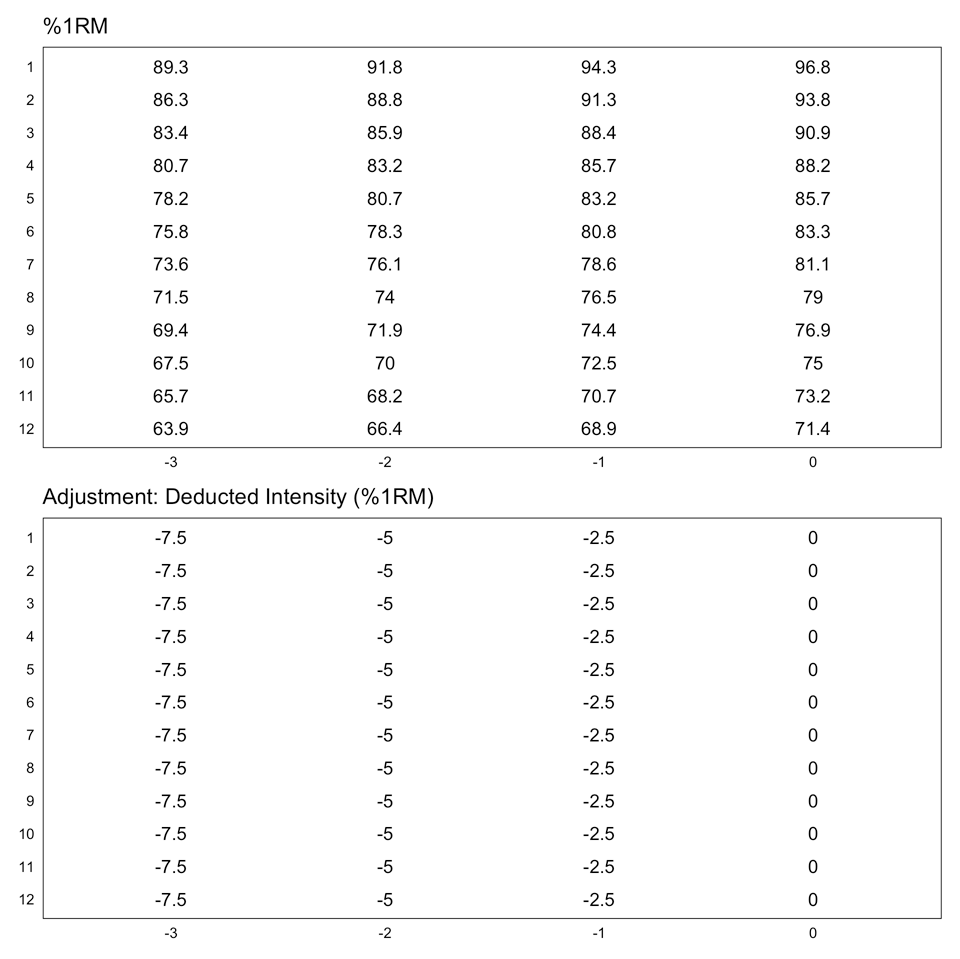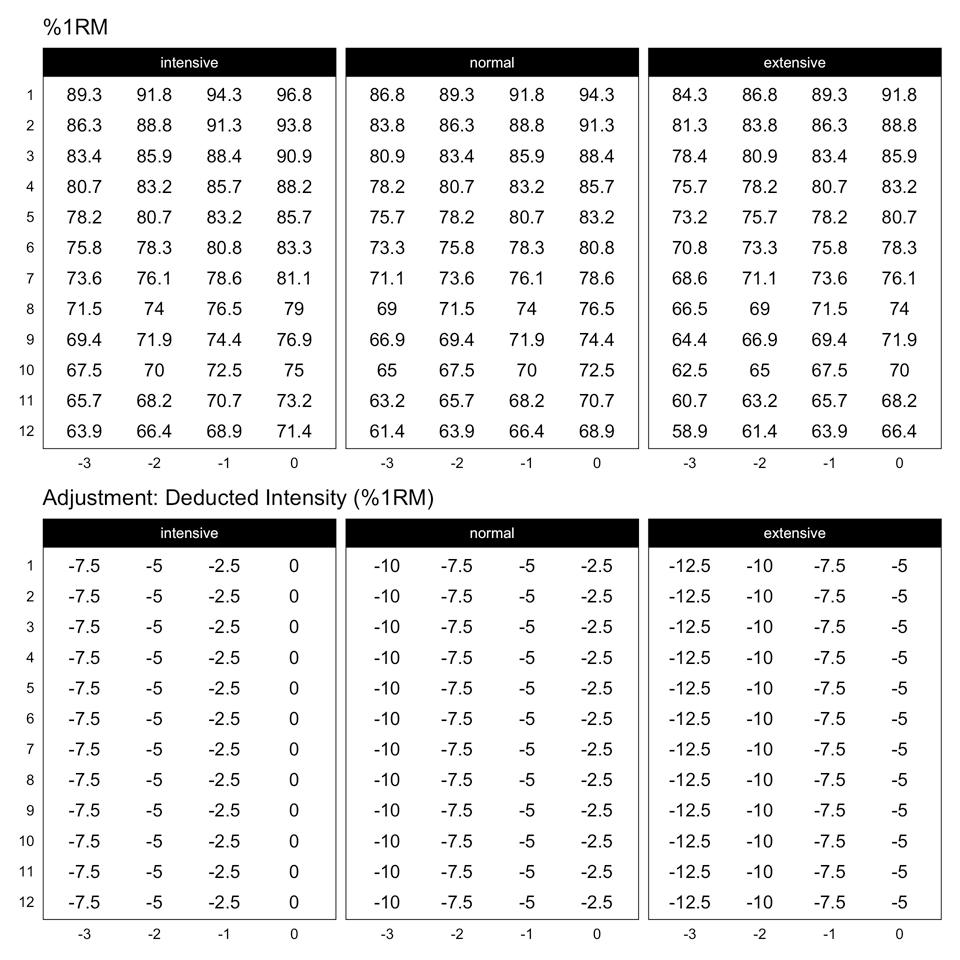Load-Exertion Tables And Their Use For Planning – Part 2
How to Progress From Here?
Although we have explored Relative Intensity (RI), Deducted Intensity (DI), Reps In Reserve (RIR), and Percent of Max Reps (%MR) approach in the previous part, I am not going to tell you which one to use. Not because I do not want to tell you, but because I do not know myself. What I will do instead, is to explore further how these can be used to create progression tables you can utilize for prescribing the resistance training.
What do I mean by “progression tables?” Using the percent-based prescription (i.e., using the %1RM), progression tables refer to a simple way of making things “harder” across training period, phase, or a block (Jovanović 2020). This most likely involves increasing the %1RM used (although other things can be done to “progress,” like increasing the number of reps performed at the same %1RM, increasing the number of sets, decreasing the rest time, modifying the tempo of the repetitions and so forth). There are other approaches for prescription of course, like using subjective indicators or velocity-based training (VBT). But understanding and using the progression tables is also very helpful with these approaches as well and represents a complementary method. Here is an example: let’s say you plan to do 3 x 5 at 2eRIR (or say 2RPE). Progression table, particularly the one using RIR, can help you find that load sooner. For more discussion regarding these topics, I recommend checking the Strength Training Manual (Jovanović 2020).
Figure 1.1 depicts a very simple progression table using the Deducted Intensity approach. Going back from the final progression step (or a week), here indicated as 0 on the x-axis, we are deducting 2.5 %1RM from designated nRM load using Epley’s equation as a model. Using this method, we started at 0RIR and 100%MR (or using the highest %1RM given the number of reps and Epley’s model) on step 0.

Figure 1: Simplest progression using Deducted Intensity approach. Here we are deducting 2.5 %1RM across progression steps, equally for every target repetitions (y-axis). Progression steps are indicated with a negative number (x-axis). The top panel (%1RM) indicates calculated %1RM to be used for each target repetition and progression step. The bottom panel (Adjustment) represents adjustments used to adjust the progression %1RM. In this case the adjustment are Deducted Intensity, or simple percentage
The simplest model depicted in Figure 1.1 represents fixed progression steps across target repetition ranges, culminating in reaching the highest %1RM on the last progression step (here indicated by step 0, since we are going backward, starting with that step as initial in the calculus). This “highest %1RM” is of course given the model used, and even if the model is completely correct, this can still miss the failure point due to either adaptation of the athlete or the accumulated fatigue (or simple variability in performance). For example, let’s assume that I am using my 100 kg bench press 1RM before this 4-weeks cycle. I am planning to do a single top set of 5 reps (1×5). In the first progression step, I should lift 78.2% * 100kg or 78 kg for five reps, culminating in 86kg in week 4. Assuming that Epley’s equation is perfectly representative for me and this lift, lifting 86kg for 5 reps in week 4, might be short of failure due to my adaptation and improved 1RM (i.e., 100kg at the beginning of the phase, or pre-cycle 1RM) that I have used to base my training phase weights. This can be of course adjusted by using “higher” %1RMs, using subjective feedback (i.e., eRIR or RPE), or shorter cycles. Or some combination of the three. More about the topics of prescription error and how to deal with them can be found in the Strength Training Manual (Jovanović 2020).
But here is the problem. My 1×5 set is not an isolated event, but part of a program and interacts with everything else. How do I modify this if I am using 5×5? One, two, or three times per week. What if I am doing this for the bench press, squat, and deadlift? What if these are done on the same day, alternate days, and so forth? What if I am tired or highly motivated? What if I am running push the ceiling versus the pull the floor program? What if the tables are wrong? What if I do not know my 1RMs for all my exercises. I will be a pain in the arse again and direct you to the Strength Training Manual (Jovanović 2020) since I have wrestled with all of those issues there and don’t want to repeat myself here. In this article, I will try to wrestle with progression tables and provide simple heuristics we can use.
Simplifying the Complexity
“As complexity rises, precise statements lose meaning and meaningful statements lose precision”
I really love Lofti Zadeh’s quote above, which I have used so many times in my writings and it is more than applicable in this complex situation as well.
So, how do we simplify and create a meaningful solution? The solution I have used in the Strength Training Manual (Jovanović 2020) is to discern between three progression tables: (1) intensive, (2) normal, and (3) extensive. Table 1 contains a summary of these tables across different characteristics.
| Characteristic | Intensive | Normal | Extensive |
|---|---|---|---|
| Proximity to failure | Closer | Medium | Further |
| Intensity used | Higest | Medium | Lowest |
| Prescription error | High | Medium | Lower |
| Volume | Low | Medium | High |
| Use when interactions are | Low | Medium | High |
| Program types to be used with | Push | Push/Pull | Pull |
Table 1: Simplification to three types of progression tables
Let’s discuss Table 1 in more detail. There are different ways to classify set and rep schemes: based on (1) objectives, qualities or traits pursued (i.e., hypertrophy, max strength, explosive strength, muscular endurance, etc), (2) prescriptiveness (i.e., schemes can be very strictly, or loosely prescribed), (3) volume (i.e., high volume, like 10×10, versus very low volume like 1×5), (4) toughness (which is the hardest classification construct to define), and (5) methodology (e.g., wave loading, sets across, ramping sets, pyramids, cluster) (Jovanović 2020). Although the intensive, normal, and extensive classification of the progression tables is mostly related to the volume characteristic of the set and rep scheme, this simplification can be meaningful across other conundrums as well.
For example, “proximity to failure,” as one of the components of the “toughness” can be addressed with intensive, normal, and extensive classification, where extensive schemes are further away from failure, while intensive are very close. The same can be said for the intensity used. Using sets of 5 as an example: extensive schemes can be 5×5 with 75%, normal can be 3×5 with 80%, while intensive can be 1×5 with 85%. This is also related to the training volume (number of lifts as a metric in this case).
Since extensive sets use lower %1RM and are thus further away from failure (but we can come very close to that point in the last set if the volume is high for example; hence the reason to use lower percentages to increase the overall do-ability), there is a lower chance of committing a prescription error, particularly “overshooting” error (Jovanović 2020). In that case, if you are dealing with an “unknown” exercise where you doubt Epley’s equation is very precise, the safest bet is to use the extensive progression tables (or to use conservative 1RM, like 80-89% of the estimated or known one). This is also very useful when there are numerous interactions. For example, when training the strength generalists who might have their sports practices. Or with strength specialists when there are numerous other exercises in the program that might “fight” for the same resource (for example, combining a lot of exercises where the grip might be compromised, like doing heavy deadlifts followed by pull-ups). It is also easy to follow up with this reasoning and conclude that intensive variants are more useful for the push the ceiling type of programs (in which the adaptation is forced or pushed, compared to pull the floor programs where progression is adjusted to the rate of adaptation; for more info please refer to the Strength Training Manual (Jovanović 2020)).
To apply these simplifications, let’s modify the simple Deducted Intensity progression by deducting an extra 2.5% 1RM for normal and intensive variants (Figure 2).

Figure 2: Simplest progression table using Deducted Intensity approach and three variants: intensive, normal, and extensive. Here we are deducting 5 %1RM across progression steps, equally for every target repetitions (y-axis). In addition to this, the normal and extensive variant has an extra 5% 1RM deducted. Progression steps are indicated with a negative number (x-axis). The top panel (%1RM) indicates calculated %1RM to be used for each target repetition and progression step. The bottom panel (Adjustment) represents adjustments used to adjust the progression %1RM. In this case the adjustment are Deducted Intensity, or simple percentage.
Table 2 contains an example of how the conservative Deducted Intensity progression table in Figure 2 is applied to two set and reps schemes (e.g., 3×5 and 3×10).
| Scheme | Step 1 | Step 2 | Step 3 | Step 4 | Step 2-1 Diff | Step 3-2 Diff | Step 4-3 Diff |
|---|---|---|---|---|---|---|---|
| 1 x 5 (intensive) | 70.7 | 75.7 | 80.7 | 85.7 | 5 | 5 | 5 |
| 3 x 5 (normal) | 65.7 | 70.7 | 75.7 | 80.7 | 5 | 5 | 5 |
| 5 x 5 (extensive) | 60.7 | 65.7 | 70.7 | 75.7 | 5 | 5 | 5 |
| 1 x 10 (intensive) | 60.0 | 65.0 | 70.0 | 75.0 | 5 | 5 | 5 |
| 3 x 10 (normal) | 55.0 | 60.0 | 65.0 | 70.0 | 5 | 5 | 5 |
| 5 x 10 (extensive) | 50.0 | 55.0 | 60.0 | 65.0 | 5 | 5 | 5 |
Table 2: Example progression for the two set and rep schemes using the conservative Deduct Intensity progression table in Figure 2.2. Columns indicate progression steps, and the numbers in the table indicate %1RM that should be used. For easier comprehension, %1RM increments from progression step to progression step are also shown in the table.
If you have read the Strength Training Manual (Jovanović 2020), you can notice the similarity between the two Deducted Intensity progression tables (Figures 1 and 2) and the Perc Drop method. Let’s explore that progression table in more detail.
Perc Drop
Although very useful, and commonly used, fixed drops in intensity (i.e., Deducted Intensity) gave me a weird feeling in the stomach. I had an intuitive issue with them in the way how low-reps and high-reps were progressed (i.e., in this case equally, by using the same deduction in intensity). Some experience and intuition (to be honest, I might have pulled this straight out of my arse) told me that the jumps in intensity from a progression step to a next progression step shouldn’t be equal across target reps. I have fixed this by using bigger jumps across progression steps for the high-reps, as well as for deduction across normal and extensive variants (Figure 3). Something told me this might be the right thing to do (but I accept this can be complete bullshit). The reason for this is that I wanted to make high-reps sets more doable, both in a single session, as well as across progression steps.











Responses